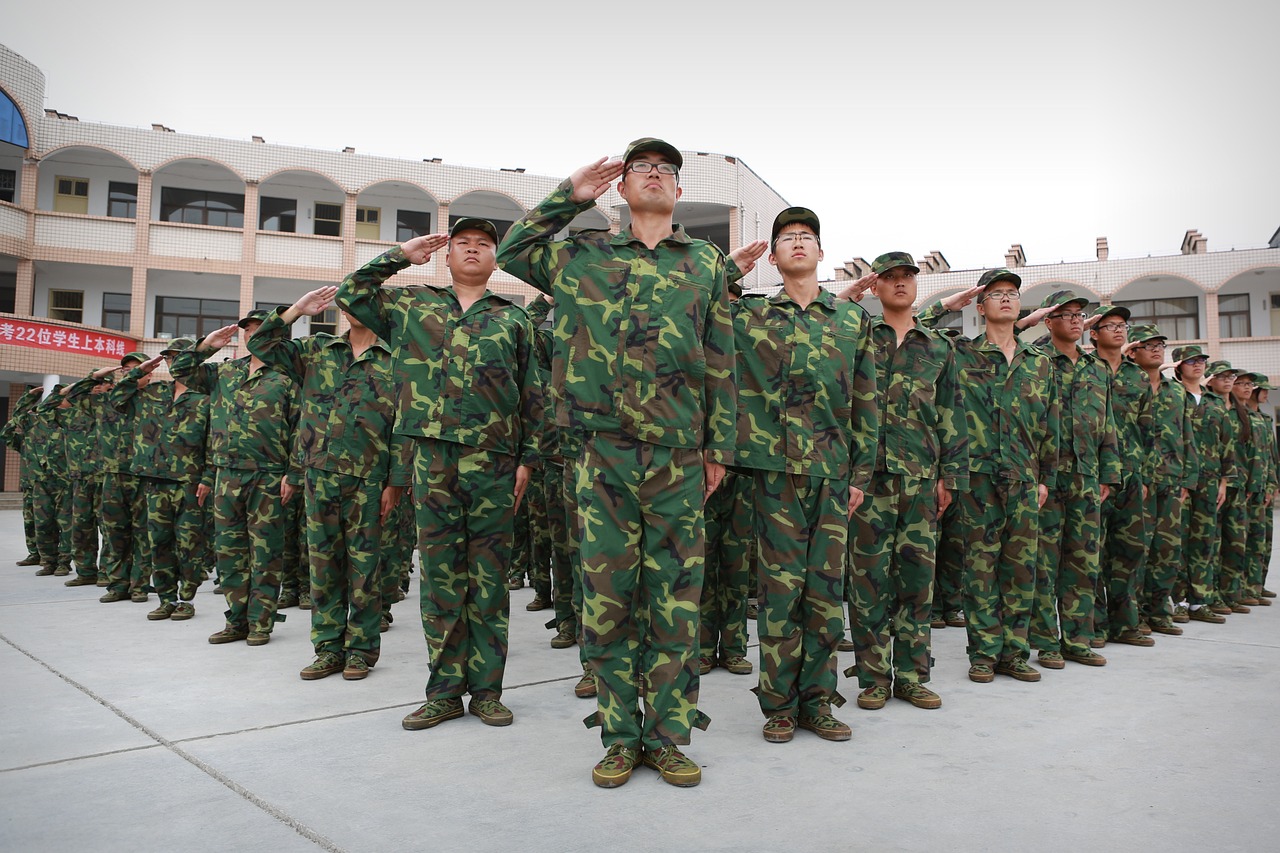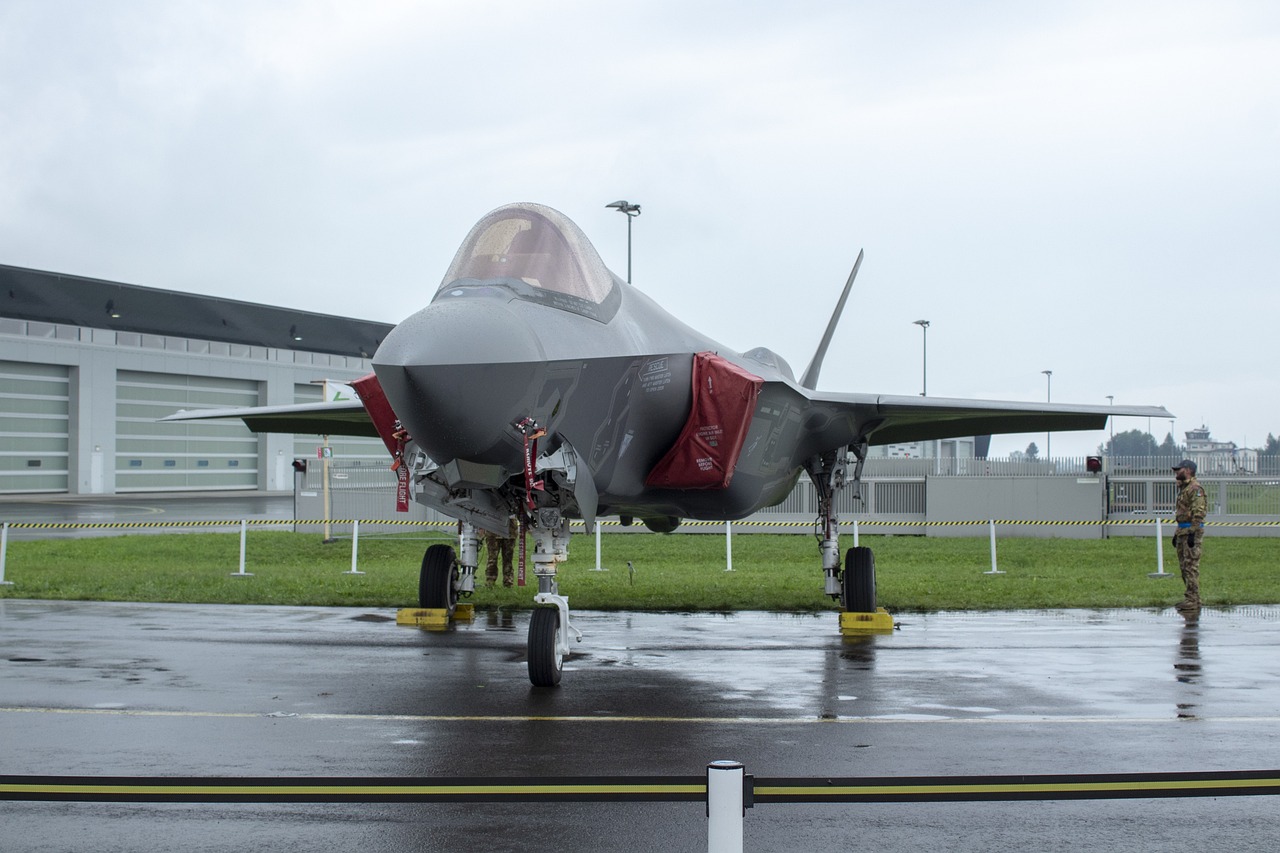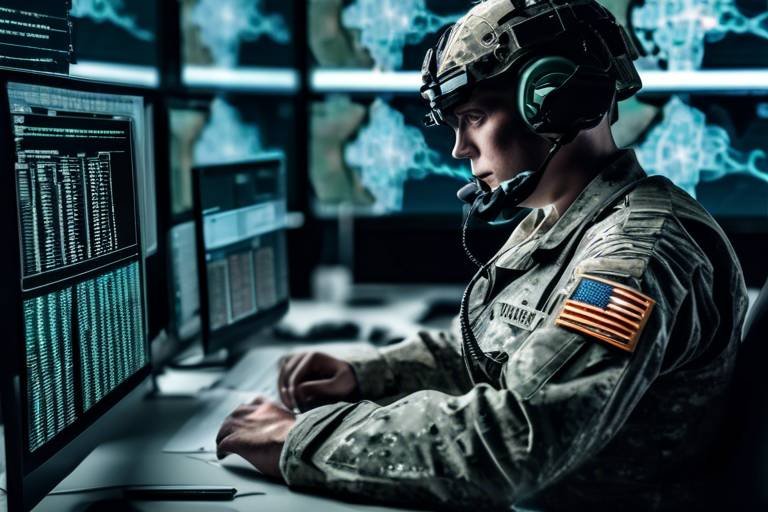Future Warfare Tactics with AI-Driven Robotics
In the ever-evolving landscape of warfare, the integration of artificial intelligence (AI) and robotics is not just a trend; it’s a revolution. The battlefield of the future will be defined by machines that can think, learn, and adapt in real-time, reshaping how conflicts are fought. Imagine a scenario where drones are not merely tools but autonomous entities making split-second decisions to outmaneuver enemy forces. This isn’t science fiction anymore; it’s the dawn of a new era in military strategy. The advent of AI-driven robotics brings forth a myriad of tactical advancements that promise to enhance combat effectiveness while also raising pressing ethical questions.
Warfare tactics have undergone significant transformations throughout history, influenced heavily by technological advancements. From the invention of gunpowder to the development of nuclear weapons, each leap in technology has redefined how wars are fought. Today, we stand at the cusp of another monumental shift, as AI and robotics begin to play pivotal roles in military operations. The capabilities of these technologies allow for unprecedented precision and efficiency, enabling forces to respond to threats with lightning speed. As we delve deeper into the implications of AI in warfare, it’s essential to recognize that these innovations are not just tools; they represent a fundamental change in the nature of conflict itself.
AI is revolutionizing military strategy by enhancing decision-making processes and operational effectiveness. The ability to analyze vast amounts of data quickly allows military leaders to make informed choices based on real-time intelligence. For instance, AI systems can process satellite imagery, intercepted communications, and ground reports to provide a comprehensive overview of enemy movements. This capability is critical in modern warfare, where the fog of war can cloud judgment and lead to costly mistakes. By leveraging predictive modeling, militaries can anticipate enemy actions, optimize resource allocation, and ultimately gain a strategic edge.
One of the most significant advantages of AI in military operations is its use of predictive analytics. This technology enables military strategists to forecast enemy movements and potential threats with remarkable accuracy. For example, by analyzing patterns in troop movements and historical data, AI can suggest optimal deployment strategies and resource distribution. This not only enhances tactical outcomes but also minimizes risks to personnel. The integration of such predictive capabilities allows for a proactive approach to combat, turning the tide in favor of those who master this technology.
In the heat of battle, timely information is crucial. AI systems excel in real-time data processing, allowing military commanders to make informed decisions on the fly. Imagine a battlefield where every second counts; AI can analyze incoming data from various sources—drones, sensors, and reconnaissance units—almost instantaneously. This rapid processing ability ensures that commanders have the most current information at their fingertips, enabling them to adjust tactics and strategies as the situation evolves. The capability to respond to threats in real-time could be the difference between victory and defeat.
AI-driven systems significantly improve situational awareness, providing a holistic view of the battlefield. By integrating data from multiple sources, including satellite imagery, ground sensors, and even social media feeds, AI can create a comprehensive overview of the operational environment. This enhanced awareness allows military leaders to identify potential threats, understand enemy intentions, and make strategic decisions based on a complete picture. In a world where information is power, the ability to synthesize and analyze data effectively is invaluable.
The deployment of autonomous robots in combat roles is one of the most exciting developments in modern warfare. These machines are designed to operate independently, making tactical decisions without human intervention. The advantages are clear: they can operate in dangerous environments without risking human lives, carry out reconnaissance missions, and even engage in combat. However, the use of autonomous robots also presents challenges, including the need for robust ethical frameworks and the potential for unintended consequences on the battlefield.
As we embrace the potential of AI in warfare, we must also grapple with the ethical implications that arise. The use of autonomous systems raises critical questions about accountability and the moral dilemmas posed by machines making life-and-death decisions. Who is responsible when an AI system malfunctions or makes an error in judgment? These questions are not just theoretical; they have real-world implications for military operations and international relations.
The issue of accountability in autonomous systems is complex and multifaceted. As AI takes on more decision-making roles in combat, determining responsibility for actions taken by these systems becomes increasingly challenging. Is it the programmer, the military leadership, or the machine itself? This uncertainty complicates the legal and ethical landscape of warfare, necessitating a reevaluation of existing frameworks to accommodate the rise of AI technology.
The potential consequences of AI warfare on civilian populations cannot be overlooked. The risks of collateral damage increase with the deployment of autonomous systems, which may not always distinguish between combatants and non-combatants. Ensuring compliance with international humanitarian law becomes more challenging as the line between human and machine decision-making blurs. It is imperative that military strategies incorporate measures to protect civilian lives and uphold ethical standards in the face of advancing technology.
Looking ahead, the future of warfare will likely be shaped by the ongoing development of AI-driven robotics. As nations continue to invest in these technologies, we can anticipate a range of scenarios that could redefine global military dynamics. The implications of such advancements are profound, influencing everything from conflict resolution to geopolitical stability.
As AI technologies become more prevalent, the potential for global conflicts exacerbated by these advancements increases. Nations may leverage robotics to gain military superiority, leading to heightened tensions and an arms race in AI capabilities. The balance of power could shift dramatically as countries vie for technological dominance, raising the stakes in international relations.
The concept of a technological arms race is not new, but the integration of AI into military capabilities adds a new dimension to this competition. Nations are not only racing to develop advanced weaponry but also to harness the power of AI for strategic advantages. This competition could lead to significant security implications, as countries seek to outpace one another in the development of autonomous systems. The global landscape of warfare is changing, and those who fail to adapt may find themselves at a disadvantage.
- What are AI-driven robotics? AI-driven robotics refer to autonomous machines that can perform tasks and make decisions using artificial intelligence.
- How does AI enhance military strategy? AI enhances military strategy by enabling data analysis, predictive modeling, and real-time decision-making, leading to more effective outcomes.
- What are the ethical concerns surrounding AI in warfare? Ethical concerns include accountability for autonomous actions, risks to civilian populations, and compliance with international humanitarian law.
- Will AI change the nature of future conflicts? Yes, AI is expected to redefine conflicts by introducing new tactics, altering power dynamics, and influencing global military strategies.

The Evolution of Warfare Tactics
The landscape of warfare has undergone dramatic transformations throughout history, with each era marked by significant advancements in technology and strategy. From the rudimentary tools of ancient combat to the sophisticated systems of modern warfare, the evolution of tactics has always been intertwined with innovation. In the early days, battles were fought using simple weapons and sheer manpower. However, as societies progressed, so did their approaches to combat. The introduction of gunpowder in the Middle Ages revolutionized warfare, leading to the development of firearms and artillery, which drastically changed battlefield dynamics.
Fast forward to the 20th century, and we see the emergence of mechanized warfare. Tanks, aircraft, and naval vessels became pivotal in shaping military strategies. World Wars I and II showcased the devastating power of these innovations, leading to a paradigm shift in how wars were fought. Tactics evolved from traditional formations to more complex strategies involving combined arms operations, where different military branches worked in unison to achieve common objectives. This period also highlighted the importance of intelligence and reconnaissance, with nations investing heavily in gathering information about enemy positions and capabilities.
As we entered the 21st century, the advent of the digital age brought about another seismic shift in warfare tactics. The rise of the internet and advanced communication technologies allowed for real-time information sharing and coordination. This era has seen the integration of cyber warfare, where the battlefield extends beyond physical confrontations to include digital arenas. Nations began to realize the importance of protecting their cyber infrastructures while simultaneously looking for ways to exploit vulnerabilities in their adversaries' systems.
With the continuous advancement of technology, we now stand on the brink of another significant transformation in military tactics, driven by artificial intelligence (AI) and robotics. These innovations promise to redefine how wars are fought, offering unprecedented capabilities in data analysis, decision-making, and operational efficiency. For instance, AI can analyze vast amounts of battlefield data in real time, providing commanders with insights that were previously unimaginable. This shift not only enhances tactical outcomes but also raises questions about the future of human involvement in warfare.
To understand the evolution of warfare tactics, we can categorize it into several key phases:
| Era | Key Innovations | Tactical Shifts |
|---|---|---|
| Ancient Warfare | Simple weapons, infantry | Manpower-based strategies |
| Medieval Warfare | Gunpowder, cannons | Artillery and fortifications |
| World Wars | Tanks, aircraft, naval power | Combined arms operations |
| Digital Age | Cyber warfare, drones | Asymmetric warfare |
| AI and Robotics | Autonomous systems, predictive analytics | Data-driven decision-making |
As we reflect on the evolution of warfare tactics, it becomes clear that each advancement has not only changed the nature of combat but also influenced global politics and societal norms. The integration of AI and robotics into military operations is likely to be the most significant shift yet, promising to enhance efficiency and effectiveness while simultaneously posing new ethical dilemmas. As we move forward, understanding these changes will be crucial for military leaders, policymakers, and civilians alike.
- How has technology influenced warfare tactics over time?
Technology has dramatically changed warfare tactics, from the introduction of gunpowder to the use of AI and robotics, enabling more effective and efficient military operations. - What role does AI play in modern military strategies?
AI enhances military strategies by providing predictive analytics, real-time data processing, and improved situational awareness, ultimately leading to better decision-making on the battlefield. - What are the ethical implications of using AI in warfare?
The use of AI in warfare raises concerns about accountability, civilian safety, and the moral dilemmas associated with autonomous weaponry.

The Role of AI in Military Strategy
Artificial Intelligence (AI) is revolutionizing the landscape of military strategy in ways that were once confined to the realm of science fiction. Gone are the days when warfare was solely dependent on human intuition and experience; today, AI brings a level of precision and analytical capability that can dramatically enhance decision-making processes. By leveraging vast amounts of data, AI can provide military strategists with insights that were previously unimaginable. Imagine having a digital assistant that can sift through terabytes of information in seconds, pinpointing trends and forecasting enemy movements with uncanny accuracy. This is not just a dream—it's the reality of modern warfare.
At the core of AI's impact on military strategy is its ability to perform predictive modeling. This involves using historical data to forecast future events, allowing military leaders to anticipate enemy actions and adjust their strategies accordingly. For instance, AI algorithms can analyze patterns in troop movements, supply chain logistics, and even social media activity to predict where an adversary might strike next. This predictive capability not only enhances operational readiness but also enables forces to allocate resources more effectively, ensuring that troops are positioned optimally for engagement.
Delving deeper into the realm of predictive analytics, we find that AI can significantly improve decision-making in high-stakes environments. In military operations, the ability to forecast enemy movements is crucial. AI systems can analyze various data points—from satellite imagery to intercepted communications—to create a comprehensive picture of the battlefield. This analysis can lead to informed decisions that save lives and resources. For example, if AI predicts an enemy's intent to launch an offensive, military leaders can preemptively reinforce defenses or reposition their forces to counter the threat.
In the heat of battle, timing is everything. AI excels in real-time data processing, allowing military personnel to react swiftly to changing conditions. Imagine a scenario where drones are gathering intelligence on enemy positions while an AI system processes this data instantaneously. Commanders can receive updates in real-time, enabling them to make quick decisions that could turn the tide of battle. This capability not only enhances tactical responses but also minimizes the fog of war, providing a clearer understanding of the operational environment.
Another significant advantage of AI in military strategy is its ability to enhance situational awareness. By integrating data from various sources—such as reconnaissance satellites, ground sensors, and even human intelligence—AI can create a holistic view of the battlefield. This comprehensive overview allows military leaders to see beyond their immediate surroundings, understanding the broader context of the conflict. The result? More informed decision-making that takes into account not just the current situation, but also potential future developments.
In conclusion, the role of AI in military strategy is transformative. It enables predictive analytics that enhance decision-making, real-time data processing that supports rapid responses, and improved situational awareness that provides a comprehensive battlefield overview. As militaries around the world continue to integrate AI technologies, the strategies employed in warfare will become increasingly sophisticated, leading to a new era of combat that prioritizes intelligence and precision.
- How does AI improve military decision-making? AI enhances decision-making by analyzing vast amounts of data to predict enemy movements and optimize resource allocation.
- What is predictive modeling in military strategy? Predictive modeling uses historical data to forecast future events, allowing military leaders to anticipate enemy actions and adjust strategies accordingly.
- Can AI systems process data in real-time? Yes, AI systems can analyze data in real-time, enabling military personnel to react swiftly to changing battlefield conditions.
- What are the benefits of enhanced situational awareness? Enhanced situational awareness allows military leaders to understand the broader context of the conflict, leading to more informed decision-making.

Predictive Analytics and Decision-Making
In the rapidly changing landscape of modern warfare, predictive analytics has emerged as a game-changer, fundamentally altering how military strategists approach decision-making. Imagine being able to foresee enemy movements and anticipate their strategies before they even unfold. This isn't science fiction—it's the power of AI-driven analytics. By harnessing vast amounts of data collected from various sources, military forces can create models that predict potential outcomes of combat scenarios with remarkable accuracy.
At its core, predictive analytics involves the use of algorithms and statistical techniques to analyze historical data and identify patterns. In a military context, this means evaluating everything from troop movements to environmental conditions and even social media activity. For instance, if a particular region shows unusual troop concentration, AI systems can analyze past conflicts in similar contexts to predict possible next steps. This proactive approach not only enhances strategic planning but also allows for rapid adaptation to unforeseen circumstances.
One of the most fascinating aspects of predictive analytics is its ability to optimize resource allocation. Imagine a battlefield where logistics are as crucial as firepower. AI can analyze supply chain data to determine the most efficient distribution of resources, ensuring that troops have the necessary equipment and support at the right time. This capability can be the difference between victory and defeat, especially in high-stakes situations where every second counts.
However, the implementation of predictive analytics is not without its challenges. The reliance on data means that any inaccuracies or biases in the data can lead to flawed predictions, potentially resulting in catastrophic decisions. Moreover, the sheer volume of data can be overwhelming, necessitating advanced real-time data processing capabilities. This is where AI's real-time processing capabilities come into play, allowing military leaders to make informed decisions based on the most current information available.
The integration of predictive analytics into military strategy also enhances situational awareness. By synthesizing data from multiple sources—satellite imagery, drone surveillance, and even human intelligence—AI systems can provide a holistic view of the battlefield. This comprehensive overview enables commanders to make better-informed decisions, reducing the fog of war that often clouds judgment in combat scenarios.
In conclusion, predictive analytics is revolutionizing military decision-making, offering unprecedented insights that empower commanders to act decisively and strategically. As technology continues to evolve, the potential for AI-driven predictive analytics to shape the future of warfare is immense, promising a new era of combat where knowledge truly is power.
- What is predictive analytics in military strategy?
Predictive analytics involves using data analysis and statistical techniques to forecast future events and outcomes in military operations. - How does AI enhance decision-making in warfare?
AI enhances decision-making by processing vast amounts of data quickly, identifying patterns, and providing actionable insights that inform military strategies. - What are the challenges of using predictive analytics in combat?
Challenges include data accuracy, potential biases, and the need for advanced real-time data processing capabilities to ensure timely and effective decision-making. - Can predictive analytics prevent military conflicts?
While predictive analytics can improve strategic planning and response, it cannot prevent conflicts entirely. It can, however, inform strategies that may mitigate risks.

Real-Time Data Processing
In the fast-paced world of modern warfare, the ability to process data in real-time is nothing short of revolutionary. Imagine being on a battlefield where every second counts, and decisions must be made swiftly and accurately. This is where AI-driven real-time data processing comes into play, acting like a digital brain that analyzes vast amounts of information instantaneously. It's akin to having a seasoned strategist right beside you, equipped with the latest intelligence and insights, ready to inform tactical decisions.
The battlefield is no longer just a physical space; it has transformed into a complex web of data streams. From satellite imagery to drone surveillance feeds, the information flow is relentless. AI systems can sift through this data, identifying patterns and anomalies that human analysts might miss. For instance, an AI could process data from multiple sources—such as troop movements, weather conditions, and supply chain logistics—simultaneously. This capability allows military leaders to adapt their strategies on the fly, ensuring they remain one step ahead of their adversaries.
Furthermore, the integration of real-time data processing enhances the effectiveness of autonomous systems. When robots are deployed on the battlefield, they rely heavily on real-time data to navigate and make decisions. For example, consider a scenario where an autonomous drone is tasked with reconnaissance. As it flies over enemy territory, it collects data on troop formations and weapon placements. With real-time processing, the drone can analyze this information instantly and relay critical insights back to command, enabling swift tactical adjustments.
However, the implications of real-time data processing extend beyond mere efficiency. It raises questions about the reliability and accuracy of the data being processed. In a world where misinformation can spread like wildfire, ensuring that AI systems are fed accurate and trustworthy data is paramount. A miscalculation or a flawed dataset could lead to catastrophic decisions on the battlefield. Thus, military operations must not only focus on the speed of data processing but also on the integrity of the information being analyzed.
In summary, real-time data processing powered by AI is reshaping the landscape of warfare. It provides military strategists with the tools they need to make informed decisions rapidly, harnessing the power of data to gain a tactical edge. Yet, as we embrace this technological advancement, we must remain vigilant about the challenges it presents, ensuring that our reliance on AI does not compromise the integrity of military operations.
- What is real-time data processing in military operations?
Real-time data processing refers to the ability to analyze and interpret data as it is collected, enabling immediate decision-making and tactical adjustments on the battlefield. - How does AI enhance real-time data processing?
AI algorithms can quickly analyze vast amounts of data from multiple sources, identifying patterns and trends that help military leaders make informed decisions rapidly. - What are the risks associated with real-time data processing?
The main risks include reliance on inaccurate or misleading data, which could lead to poor decision-making and potentially disastrous outcomes in combat scenarios.

Enhanced Situational Awareness
In the chaotic realm of modern warfare, situational awareness is the bedrock upon which successful military operations are built. Imagine being on a battlefield where every move counts, and the fog of war can obscure critical information. This is where AI-driven systems step in, transforming how military personnel perceive and respond to their environment. By integrating various data sources—such as satellite imagery, drone feeds, and ground-level intelligence—AI creates a comprehensive overview of the battlefield, enabling commanders to make informed decisions swiftly.
One of the most significant advantages of enhanced situational awareness is the ability to process vast amounts of data in real-time. Traditional methods of gathering intelligence often involve delays and can lead to outdated information being used in critical moments. However, AI systems can analyze incoming data streams at lightning speed, identifying patterns and anomalies that human operators might miss. This capability not only improves the accuracy of threat assessments but also allows for rapid adjustments in strategy as situations evolve.
For instance, consider a scenario where enemy movements are detected through various sensors. An AI system can aggregate this information, cross-reference it with historical data, and predict potential future actions of the adversary. This predictive power is akin to having a chess grandmaster on your side, always thinking several moves ahead. The result is a tactical advantage that can turn the tide of battle.
Moreover, enhanced situational awareness promotes collaboration among different branches of the military. With AI systems acting as a central hub for information, soldiers on the ground, pilots in the air, and naval forces at sea can share insights and coordinate efforts seamlessly. This interconnectedness is essential in modern warfare, where operations often span multiple domains.
However, it’s important to acknowledge the challenges that come with this technological leap. While AI can significantly enhance situational awareness, it also raises questions about reliability and trust. How much should military personnel rely on AI when making life-and-death decisions? The integration of AI systems must be approached with caution, ensuring that human oversight remains a critical component of military operations.
In summary, enhanced situational awareness through AI-driven systems holds the potential to revolutionize military operations. By offering real-time insights and predictive analytics, these technologies can empower military forces to act decisively and effectively. Yet, as we embrace these advancements, we must also remain vigilant about the ethical implications and the need for human oversight in the decision-making process.
- What is situational awareness in military terms? Situational awareness refers to the understanding of the environment and events that are happening in real-time, allowing military personnel to make informed decisions.
- How does AI improve situational awareness? AI enhances situational awareness by processing vast amounts of data quickly, identifying patterns, and predicting enemy movements, leading to more effective tactical decisions.
- What are the challenges of using AI in military operations? Challenges include issues of reliability, the need for human oversight, and ethical considerations regarding decision-making in combat scenarios.
- Can AI systems operate autonomously without human intervention? While AI can assist in decision-making, it is crucial to maintain human oversight to ensure accountability and ethical considerations in military operations.

Autonomous Robotics in Combat
As we step into an era where technology and warfare intertwine like never before, the deployment of autonomous robotics in combat roles is reshaping the battlefield landscape. Imagine a scenario where machines, equipped with artificial intelligence, can make split-second decisions in the heat of battle—this is not science fiction; it’s becoming a reality. These robots, designed for various combat functions, are not just tools but potential game-changers that can alter the dynamics of military engagements.
One of the key advantages of autonomous robotics is their ability to operate in environments that are too dangerous for human soldiers. For instance, in situations involving chemical or biological threats, deploying a robot can significantly reduce the risk to human life. Additionally, these machines can be engineered to perform tasks that require precision and speed beyond human capability. From reconnaissance missions to direct combat, the versatility of autonomous robots opens up a range of tactical possibilities.
However, the integration of robotics in combat is not without its challenges. The question of reliability looms large—how can we ensure that these machines make the right decisions under pressure? The unpredictability of warfare means that even the most advanced AI can face dilemmas that challenge its programming. Moreover, the potential for malfunctions or hacking raises concerns about the safety and security of military operations. It’s crucial for military strategists to consider these factors when deploying autonomous systems.
Here are some of the primary roles that autonomous robots are expected to play in combat:
- Surveillance and Reconnaissance: Equipped with advanced sensors, these robots can gather intelligence without putting soldiers in harm's way.
- Logistics and Supply Chain Management: Autonomous vehicles can transport supplies to troops in remote areas, ensuring that they remain well-equipped.
- Combat Support: From drone strikes to ground support, autonomous systems can engage the enemy with precision strikes, minimizing collateral damage.
- Medical Assistance: Robots can be deployed to evacuate injured personnel, providing critical support in hostile environments.
In essence, the deployment of autonomous robotics in combat signifies a profound shift in military strategy. The ability to leverage AI-driven machines for various roles not only enhances operational efficiency but also poses new ethical and tactical challenges. As we venture further into this technological frontier, it's imperative to strike a balance between innovation and responsibility, ensuring that these powerful tools are used wisely and judiciously.
Q: What are autonomous robots in combat?
A: Autonomous robots in combat are machines equipped with artificial intelligence that can perform military tasks without direct human control, such as reconnaissance, logistics, and even combat support.
Q: What are the advantages of using autonomous robots in warfare?
A: They can operate in dangerous environments, reduce risks to human soldiers, and perform tasks with precision and speed that may surpass human capabilities.
Q: What challenges do autonomous robots face in combat?
A: Reliability, potential malfunctions, hacking risks, and ethical concerns regarding decision-making in life-and-death situations are significant challenges.
Q: How do autonomous robots impact military strategy?
A: They enhance operational efficiency and open new tactical possibilities while also raising ethical questions about the use of AI in warfare.

Ethical Considerations of AI Warfare
The rise of AI in warfare brings with it a host of ethical dilemmas that society must confront. As we integrate sophisticated technologies into military operations, questions about accountability, civilian safety, and moral responsibility loom large. Imagine a battlefield where decisions are made not by human soldiers, but by algorithms and machines. This shift raises significant concerns that challenge our traditional views on warfare and the laws that govern it.
One of the most pressing issues is accountability in autonomous systems. When an AI-driven drone mistakenly targets a civilian area, who is held responsible? Is it the programmer who wrote the code, the military leaders who deployed it, or the machine itself? This ambiguity creates a legal and moral gray area that could lead to a lack of accountability in military operations. As technology advances, we must consider how to establish clear lines of responsibility for actions taken by autonomous systems. The challenge lies in creating frameworks that can adapt to these new realities while ensuring justice and accountability are upheld.
Moreover, the impact of AI warfare on civilian populations cannot be overlooked. The potential for collateral damage increases with the use of autonomous weapons, which may not fully comprehend the complexities of human environments. For example, an AI system tasked with targeting enemy combatants might misinterpret data, resulting in devastating consequences for innocent bystanders. This raises the question: how can we ensure compliance with international humanitarian law in a landscape where machines make life-and-death decisions? The risks of miscalculations are stark, and the ethical implications are profound.
In addition to accountability and civilian safety, we must also consider the moral implications of autonomous weaponry. The idea of machines making decisions about life and death challenges our very understanding of warfare. Should we allow machines to decide who lives and who dies? This question echoes the sentiments of many ethicists and military leaders alike. As we move forward, it’s crucial to engage in dialogues that include diverse perspectives—from technologists and military strategists to ethicists and human rights advocates. Together, we can explore frameworks that guide the ethical use of AI in warfare, ensuring that human dignity remains at the forefront of military operations.
Ultimately, the integration of AI in warfare is not just a technological challenge; it is a profound ethical dilemma that requires careful consideration. As we stand on the brink of this new era, we must navigate these waters with caution and foresight, ensuring that our advancements do not come at the cost of our humanity.
- What are the main ethical concerns surrounding AI in warfare?
The primary concerns include accountability for actions taken by autonomous systems, the potential for collateral damage to civilian populations, and the moral implications of allowing machines to make life-and-death decisions.
- Who is responsible if an AI weapon causes unintended harm?
Accountability is a complex issue; it could fall on the developers, military leadership, or the operators of the systems, depending on the circumstances and legal frameworks in place.
- How can we ensure compliance with humanitarian laws in AI warfare?
Establishing clear guidelines and protocols for the use of AI in military operations, along with robust oversight mechanisms, is essential to ensure compliance with international humanitarian law.
- What role should ethics play in the development of military AI?
Ethics should be integral to the development process, guiding decisions about how AI systems are designed, deployed, and monitored to prevent misuse and protect human rights.

Accountability in Autonomous Systems
As we dive deeper into the realm of AI-driven warfare, the question of accountability emerges as a critical issue. When autonomous systems make decisions that lead to combat actions, who is held responsible? Is it the programmer, the military command, or the machine itself? This conundrum poses significant challenges, not just for legal frameworks, but also for ethical considerations in warfare.
Imagine a scenario where an autonomous drone identifies what it perceives as a hostile target and engages it, resulting in unintended civilian casualties. In traditional warfare, accountability could be traced back to a commanding officer or a soldier who executed the order. However, with AI, the lines blur. The decision-making process is not solely human-driven; it incorporates algorithms and data that may not be fully understood even by their creators. This raises the question: can we truly hold a machine accountable for its actions?
To tackle this dilemma, some experts suggest implementing a framework for accountability that involves multiple stakeholders. This might include:
- Developers: Those who create the algorithms must ensure transparency and ethical programming.
- Military Command: Leaders must take responsibility for how these systems are deployed and used in combat.
- Governments: National policies should regulate the use of autonomous weapons, ensuring compliance with international law.
Moreover, the concept of “meaningful human control” has been proposed as a way to maintain accountability. This means that while AI systems may assist in decision-making, a human operator should always have the final say in critical military actions. This approach not only preserves accountability but also mitigates risks associated with fully autonomous systems.
As we move forward, it is essential to establish clear guidelines and legal standards that address these accountability issues. The international community must engage in discussions to create a consensus on how to handle the challenges posed by AI in warfare. After all, the implications of failing to establish accountability could lead to severe consequences, not just for military personnel but also for innocent civilians caught in the crossfire.
- Who is responsible for the actions of autonomous military systems?
Responsibility can lie with developers, military commanders, and governments, depending on the context of the deployment and use of the technology. - What is meant by meaningful human control?
This concept emphasizes that a human operator should retain the ability to make final decisions regarding military actions, even when AI assists in the process. - How can we ensure ethical programming in AI military systems?
Developers should adhere to ethical guidelines and transparency standards while creating algorithms to ensure that they align with humanitarian principles. - What are the risks of not addressing accountability in AI warfare?
Failure to establish accountability could result in unregulated use of autonomous weapons, leading to increased civilian casualties and violations of international law.

Impact on Civilian Populations
The deployment of AI-driven robotics in warfare is a double-edged sword, with significant implications for civilian populations. As military operations become increasingly automated, the potential for unintended consequences rises, leading to concerns about collateral damage and civilian safety. In the chaos of modern combat, where split-second decisions can mean the difference between life and death, the reliance on machines raises crucial questions about the reliability and ethics of these systems.
One of the most pressing issues is the risk of collateral damage. Autonomous systems, while designed to improve precision, can misinterpret data or fail to recognize civilians amidst combatants. For instance, a drone might identify a target based on movement patterns, but if those patterns are present in a civilian gathering, the results could be catastrophic. This unpredictability poses a serious challenge to the principles of international humanitarian law, which seeks to protect non-combatants during armed conflicts.
Moreover, the integration of AI in warfare can lead to a desensitization of combat. When decisions about life and death are made by algorithms rather than human judgment, it can create a disconnect between military personnel and the realities of war. This detachment might encourage a more aggressive approach to conflict, as the perceived risks to human life diminish. The moral implications of such a shift cannot be overstated, as it challenges the very essence of what it means to wage war responsibly.
Another significant concern is the psychological impact on civilian populations. The mere presence of autonomous military systems can instill fear and uncertainty among non-combatants. Imagine living in a region where drones patrol the skies, watching every movement. This constant surveillance can lead to a sense of vulnerability and anxiety, affecting the mental health of individuals and communities. In addition, the unpredictability of robotic warfare can disrupt daily life, forcing civilians to adapt to an environment of fear and instability.
To illustrate these points, consider the following table that outlines potential impacts of AI warfare on civilian populations:
| Impact Area | Description |
|---|---|
| Collateral Damage | Unintended harm to civilians due to misidentification of targets by AI systems. |
| Desensitization | Reduced human empathy in military operations, leading to more aggressive tactics. |
| Psychological Impact | Increased anxiety and fear among civilians living in combat zones monitored by AI. |
In conclusion, while AI-driven robotics offer the potential for enhanced military efficiency, the implications for civilian populations are profound and concerning. As we move forward, it is crucial for military strategists, policymakers, and technologists to engage in meaningful conversations about the ethical use of these technologies. Balancing the advantages of AI in warfare with the responsibility to protect civilian lives is not just a legal obligation, but a moral imperative that should guide future developments in military technology.
- What is collateral damage in the context of AI warfare? Collateral damage refers to unintentional harm inflicted on civilians or non-combatants during military operations, particularly when autonomous systems misidentify targets.
- How does AI desensitize military personnel? AI can create a disconnect between soldiers and the realities of war, as decisions may be made by machines rather than through human judgment, potentially leading to more aggressive tactics.
- What psychological effects can AI warfare have on civilians? The presence of AI-driven military systems can induce fear and anxiety among civilian populations, disrupting their daily lives and affecting their mental health.
- What ethical concerns arise from the use of AI in warfare? Ethical concerns include accountability for actions taken by autonomous systems, the potential for increased collateral damage, and the moral implications of desensitization to violence.

Future Scenarios in AI Warfare
As we peer into the crystal ball of military innovation, the future scenarios in AI warfare paint a picture that is as thrilling as it is concerning. The integration of AI-driven robotics is not merely a trend; it’s a seismic shift in how nations prepare for and engage in conflict. Imagine a battlefield where autonomous drones zip through the air, making real-time decisions based on vast amounts of data, while ground-based robots maneuver with precision, executing tactical maneuvers with minimal human intervention. This is not science fiction—it is the potential reality of future combat scenarios.
One of the most pressing questions is how these advancements will influence global conflicts. As nations race to develop superior AI technologies, we could see a new form of warfare emerge, characterized by rapid, automated engagements. The potential for robotic armies could lead to conflicts that escalate quickly, as nations might feel emboldened to strike first, knowing that their AI systems can process information and respond faster than any human could. This could create a precarious situation where the line between peace and war becomes dangerously thin.
Furthermore, the concept of a technological arms race looms large. Countries will likely invest heavily in AI military capabilities, not just for defense but also for offensive strategies. This competition could lead to a world where nations are continuously trying to outdo each other in developing more advanced autonomous systems. The implications of this arms race are profound, as it raises questions about stability and security on a global scale. Are we prepared for a world where the decision to engage in combat could be made by algorithms?
In addition to military strategies, the ethical dimensions of AI warfare will also shape future scenarios. The deployment of autonomous weapons raises significant moral questions. For instance, who is accountable when an AI system makes a mistake? If a drone misidentifies a target and causes civilian casualties, can we hold anyone responsible? These dilemmas will challenge international laws and may lead to new treaties aimed at regulating the use of AI in warfare.
Moreover, as AI technologies evolve, we can expect a shift in how conflicts are resolved. Traditional methods of diplomacy may become less effective as nations rely more on automated systems. The reliance on AI could mean that military solutions are prioritized over diplomatic negotiations, leading to an increase in armed conflicts and a decrease in peaceful resolutions. This scenario emphasizes the need for a robust framework to manage AI technologies in warfare, ensuring that they are used responsibly and ethically.
In conclusion, the future of AI in warfare is filled with both promise and peril. As we advance into this new era, it is crucial for policymakers, military leaders, and ethicists to engage in discussions about the implications of these technologies. The decisions made today will shape the landscape of warfare for generations to come. How we navigate these challenges will determine whether AI becomes a tool for peace or a catalyst for conflict.
- What are the primary benefits of AI in warfare? AI can enhance decision-making, improve situational awareness, and increase operational efficiency.
- What ethical concerns are associated with AI warfare? Key concerns include accountability for autonomous actions, potential civilian casualties, and the moral implications of using machines in combat.
- How might AI change the nature of global conflicts? AI could lead to faster, more automated engagements, increasing the risk of escalation and complicating diplomatic efforts.
- What is a technological arms race? It refers to the competition among nations to develop superior military technologies, including AI-driven systems, which can impact global security dynamics.

Potential Global Conflicts
As we gaze into the future of warfare, the specter of AI-driven robotics looms large, promising to reshape the landscape of global conflicts. Imagine a world where nations leverage cutting-edge technologies to gain strategic advantages, leading to a new era of military engagement. The potential for conflict escalation is palpable, as countries may find themselves in a race to develop the most advanced robotic systems. This scenario raises pressing questions: How will these technologies influence geopolitical stability? Will nations engage in preemptive strikes, fearing that their adversaries might gain an upper hand?
The integration of AI in military operations could lead to a paradigm shift in how conflicts are initiated and fought. For instance, consider a situation where an AI system predicts a rival nation's military build-up. This predictive capability could trigger a series of responses, including diplomatic maneuvers, economic sanctions, or even military mobilization. The result? A potential conflict sparked not by direct aggression but by the fear of being outmatched. The stakes are higher than ever, as the lines between offense and defense blur, creating a precarious balance of power.
Furthermore, the role of autonomous systems in warfare introduces a new dimension to conflict scenarios. These robots, capable of operating independently or semi-independently, can conduct surveillance, engage in combat, and even make tactical decisions. The deployment of such technologies could lead to rapid escalations, as nations might feel compelled to respond swiftly to perceived threats. The speed at which these machines can operate might outpace human decision-making, leading to a situation where conflicts spiral out of control before leaders can intervene.
In this evolving landscape, the potential for proxy wars also increases. Countries may choose to support autonomous robotic systems in conflicts, further complicating the battlefield. Instead of traditional boots on the ground, we might see nations providing AI-enhanced weaponry to allies, creating a web of interconnected conflicts that could ignite global tensions. The implications of this shift are profound, as the nature of warfare transforms from direct confrontations to a more insidious form of conflict, fought through technology and automation.
Moreover, the emergence of a technological arms race cannot be overlooked. Nations will likely invest heavily in research and development to outpace one another, leading to a cycle of innovation and counter-innovation. This race could divert resources from critical areas such as education, healthcare, and infrastructure, ultimately impacting global stability. As countries vie for supremacy in AI warfare, the potential for miscalculations and misunderstandings increases, heightening the risk of unintended conflicts.
In conclusion, the future of global conflicts in the age of AI-driven robotics is fraught with uncertainty. The interplay between technology, strategy, and human decision-making will define the next chapter of warfare. As we move forward, it is crucial for policymakers and military leaders to consider the implications of these advancements, ensuring that the pursuit of technological superiority does not come at the expense of global peace and security.
- What are the main concerns regarding AI in warfare? The primary concerns include accountability for autonomous actions, potential civilian casualties, and the risk of escalating conflicts due to miscalculations.
- How might AI-driven robotics change military strategies? AI can enhance predictive analytics, improve situational awareness, and enable faster decision-making, potentially leading to more effective military operations.
- What is a technological arms race in the context of AI warfare? It refers to the competition among nations to develop advanced military technologies, which can lead to increased tensions and the potential for conflict.

Technological Arms Race
The is a phenomenon that has been escalating dramatically in recent years, particularly in the realm of military capabilities driven by artificial intelligence (AI). Nations across the globe are pouring resources into developing advanced AI technologies that can enhance their military prowess. This race is not merely about having the most sophisticated weapons; it's about achieving strategic superiority that could determine the outcome of future conflicts. Imagine a world where the speed of decision-making and execution on the battlefield is dictated by algorithms rather than human intuition—this is the reality that many countries are racing towards.
As countries invest heavily in AI, the landscape of warfare is shifting. The integration of autonomous systems, machine learning, and advanced data analytics into military operations is becoming the norm. This shift raises critical questions about national security and the balance of power. For instance, nations like the United States, China, and Russia are leading the charge, each striving to outpace the others in developing cutting-edge military technologies. The competition is fierce, and the stakes are incredibly high.
In this context, the race isn't just about who has the best technology; it also involves strategic alliances and partnerships. Countries are collaborating with tech firms and research institutions to accelerate their advancements in AI. This collaboration can be seen in various forms, such as:
- Joint military exercises focused on AI integration
- Research partnerships between governments and private tech companies
- International agreements on AI ethics in warfare
However, this technological arms race is not without its challenges. As nations rush to develop AI capabilities, they often overlook the ethical implications of such advancements. The potential for misuse or accidental engagement of autonomous weapons systems raises serious concerns about accountability and civilian safety. The question remains: who is responsible when an AI-driven drone makes a fatal mistake?
Moreover, the rapid pace of technological development can lead to unforeseen consequences. For instance, as nations enhance their military capabilities, they may inadvertently provoke an arms race that destabilizes global peace. The fear of falling behind can lead to hasty decisions, where countries prioritize speed over thorough testing and ethical considerations. This scenario could create a precarious situation where the line between defense and aggression blurs, leading to an escalation of conflicts.
In conclusion, the spurred by AI is reshaping the dynamics of global military power. As nations strive to outdo each other in developing advanced military technologies, the implications for international relations and global security are profound. The challenge lies not only in keeping pace with technological advancements but also in ensuring that these developments are guided by ethical considerations and a commitment to peace.
- What is a technological arms race? A technological arms race refers to the competition between nations to develop superior military technologies and capabilities, particularly in the context of AI and robotics.
- How does AI impact military strategy? AI enhances military strategy by improving data analysis, predictive modeling, and decision-making, leading to more effective tactical outcomes.
- What are the ethical concerns associated with AI in warfare? Ethical concerns include accountability for autonomous systems, potential civilian casualties, and the moral implications of using AI-driven weapons.
- Which countries are leading the technological arms race? Countries like the United States, China, and Russia are at the forefront of developing advanced AI military capabilities.
Frequently Asked Questions
- What are AI-driven robotics in warfare?
AI-driven robotics refer to autonomous machines that utilize artificial intelligence to perform tasks in military operations. These robots can analyze data, make decisions, and execute missions without human intervention, significantly changing the landscape of modern warfare.
- How does AI enhance military strategy?
AI enhances military strategy by processing vast amounts of data to identify patterns and predict enemy movements. This predictive analytics capability allows military leaders to make informed decisions quickly, improving the effectiveness of their tactical operations.
- What are the ethical concerns surrounding AI in warfare?
The ethical concerns include accountability for actions taken by autonomous systems, the potential for collateral damage to civilian populations, and the moral implications of using machines to make life-and-death decisions. These issues raise significant questions about the future of warfare and the responsibility of military leaders.
- How do autonomous robots improve situational awareness?
Autonomous robots improve situational awareness by integrating data from various sources, such as satellites, drones, and ground sensors. This comprehensive overview allows military personnel to understand the battlefield dynamics better and respond to threats more effectively.
- What might future conflicts look like with AI-driven warfare?
Future conflicts could involve rapid, tech-driven engagements where nations utilize AI-driven robotics for strategic advantages. This could lead to new forms of warfare, including cyber warfare and unmanned combat, fundamentally altering how wars are fought and won.
- Is there a risk of a technological arms race?
Yes, the development of AI military capabilities could spark a technological arms race among nations. As countries strive to outdo each other in AI advancements, this competition may lead to increased global tensions and instability, raising concerns about security and international relations.



















